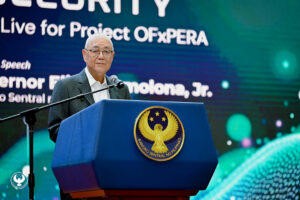By Katherine K. Chan
THE LIMIT on unprogrammed appropriations (UAs) in the government’s proposed budget modernization bill holds the potential to deter budget “insertions,” the Department of Budget and Management (DBM) said.
Assistant Budget Secretary Romeo Matthew T. Balanquit said the DBM typically sends a draft spending plan to Congress with a certain amount of UAs that double or triple once Congress is through legislating it.
“Bumabalik ’yan sa amin under the GAA (General Appropriations Act), nadodoble o natitriple (it comes back to us as a GAA bill with double or triple the original level),” Mr. Balanquit told reporters on the sidelines of an event on Monday.
“That’s something that we don’t have control over. But hopefully, under the law, halimbawa ma-push ’yung Philippine budget code, magkakaroon ng cap ’yan (for example if the Philippine budget code goes through, there will be a cap on that),” he added.
UA spending is considered contingent on the availability of funds, which will require the government to either exceed its revenue targets or borrow more.
The budget process has been plagued by last-minute insertions and amendments at the bicameral conference committee level, spurring calls to do away with UAs.
Budget Secretary Amenah F. Pangandaman and the Palace, on separate occasions, have defended UAs, saying that some allowance must be made for unforeseen spending needs.
Ms. Pangandaman has proposed a 5% ceiling on UAs in the National Expenditure Program (NEP), the document prepared by the DBM which Congress then converts into a budget bill.
GlobalSource Partners country analyst Diwa C. Guinigundo said any wiggle room on UAs “opens the floodgates for abuse.”
“This is the best time to get rid of UA — it has been misused all these years to finance corruption through congressional insertions,” he said via Viber. “DBM together with all line agencies and other instrumentalities of government should sharpen their pencils in capturing key expenditure items already based on one, necessary and priority list and two, absorptive capacity.”
Mr. Guinigundo said the government should not fund programs that are not spelled out in the national budget.
“Even disaster and emergency situations should have been covered by risk management and scenario-building exercises of various agencies of government,” he said. “Kunin sa discretionary funds ng Malacañang if disaster funds are not enough (Take it from the discretionary funds of Malacañang if disaster funds are not enough).”
Finance Secretary Ralph G. Recto has called a 5% UA cap excessive and “maybe” 2% would be sufficient.
Mr. Balanquit said he prefers any UAs to be “the lower the better.”
In the 2026 NEP, unprogrammed appropriations have amounted to P243 billion so far, equivalent to about 3.6% of the P6.793-trillion proposed spending plan.
A cap of 5% would imply a UA level of around P340 billion.
Mr. Balanquit said that the government’s current cash budgeting system still gives legislators room to modify the level of programmed funds for infrastructure projects, allowing for potential budget misuse.
“’Yung sinasabi naming cash budgeting system is somehow just being implemented. Pero… walang kapit because in the end, ginagalaw pa rin ng Congress (The cash budgeting system we’re referring to is somehow just being implemented. However… it has not taken hold because, in the end, Congress will manipulates it),” Mr. Balanquit said.
The proposed Progressive Budgeting for Better and Modernized Governance Bill has been included in the Legislative-Executive Development Advisory Council’s 44 priority bills for the 20th Congress.
The measure seeks to introduce reforms to the budget and public financial management process by institutionalizing the Cash Budgeting System, the Treasury Single Account and the Integrated Financial Management Information System.


















